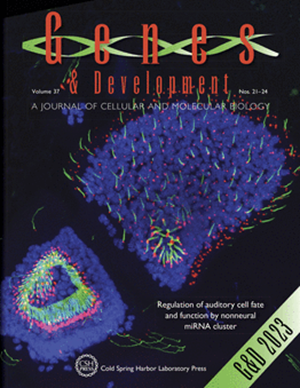MEF2C controls segment-specific gene regulatory networks that direct heart tube morphogenesis
IF 7.7
1区 生物学
Q1 CELL BIOLOGY
引用次数: 0
Abstract
The gene regulatory networks (GRNs) that control early heart formation are beginning to be understood, but lineage-specific GRNs remain largely undefined. We investigated networks controlled by the vital transcription factor MEF2C using a time course of single-nucleus RNA sequencing and ATAC sequencing in wild-type and Mef2c-null embryos. We identified a “posteriorized” cardiac gene signature and chromatin landscape in the absence of MEF2C. Integrating our multiomics data in a deep learning-based model, we constructed developmental trajectories for each of the outflow tract, ventricular, and inflow tract segments and alterations of these in Mef2c-null embryos. We computationally identified segment-specific MEF2C-dependent enhancers with activity in the developing zebrafish heart. Finally, using inferred GRNs, we discovered that the Mef2c-null heart malformations are partly driven by increased activity of the nuclear hormone receptor NR2F2. Our results delineate lineage-specific GRNs in the early heart tube and provide a generalizable framework for dissecting transcriptional networks governing developmental processes.MEF2C控制直接心管形态发生的片段特异性基因调控网络
控制早期心脏形成的基因调控网络(grn)开始被理解,但谱系特异性grn在很大程度上仍然不明确。我们在野生型和MEF2C缺失的胚胎中使用单核RNA测序和ATAC测序的时间过程来研究由重要转录因子MEF2C控制的网络。我们确定了在缺乏MEF2C的情况下心脏基因标记和染色质景观的“后置化”。将我们的多组学数据整合到一个基于深度学习的模型中,我们构建了mef2c缺失胚胎流出道、心室和流入道各部分的发育轨迹及其变化。我们通过计算确定了在发育中的斑马鱼心脏中具有活性的片段特异性mef2c依赖性增强子。最后,使用推断的grn,我们发现Mef2c-null心脏畸形部分是由核激素受体NR2F2活性增加引起的。我们的研究结果描绘了早期心脏管中的谱系特异性grn,并为解剖控制发育过程的转录网络提供了一个可推广的框架。
本文章由计算机程序翻译,如有差异,请以英文原文为准。
求助全文
约1分钟内获得全文
求助全文
来源期刊

Genes & development
生物-发育生物学
CiteScore
17.50
自引率
1.90%
发文量
71
审稿时长
3-6 weeks
期刊介绍:
Genes & Development is a research journal published in association with The Genetics Society. It publishes high-quality research papers in the areas of molecular biology, molecular genetics, and related fields. The journal features various research formats including Research papers, short Research Communications, and Resource/Methodology papers.
Genes & Development has gained recognition and is considered as one of the Top Five Research Journals in the field of Molecular Biology and Genetics. It has an impressive Impact Factor of 12.89. The journal is ranked #2 among Developmental Biology research journals, #5 in Genetics and Heredity, and is among the Top 20 in Cell Biology (according to ISI Journal Citation Reports®, 2021).
 求助内容:
求助内容: 应助结果提醒方式:
应助结果提醒方式:


